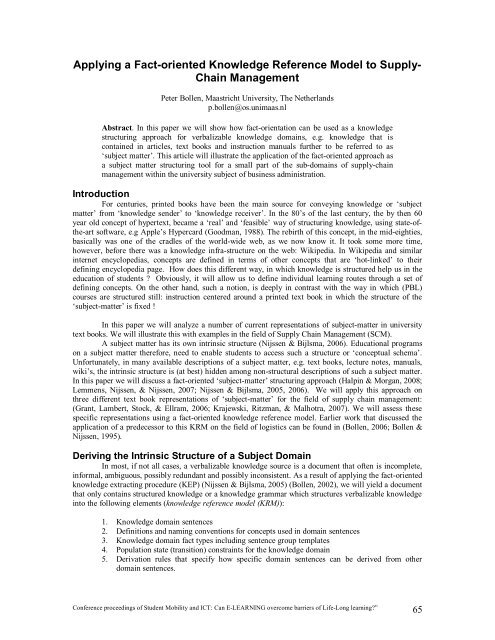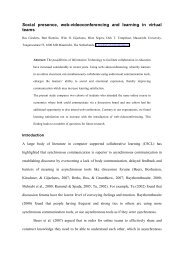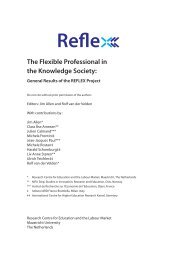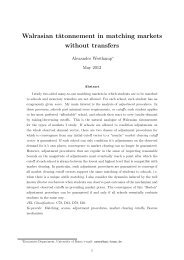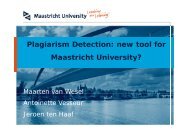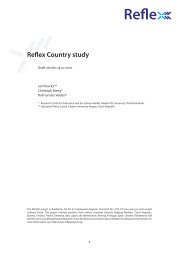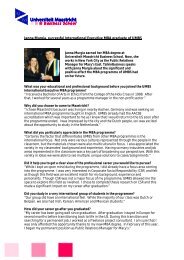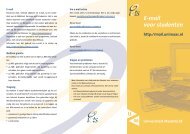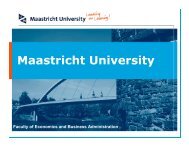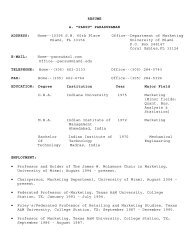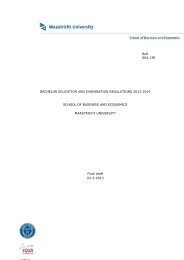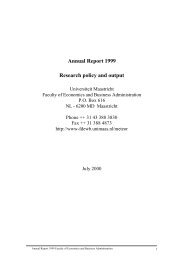proceedings of Student Mobility and ICT: Can E-LEARNING
proceedings of Student Mobility and ICT: Can E-LEARNING
proceedings of Student Mobility and ICT: Can E-LEARNING
You also want an ePaper? Increase the reach of your titles
YUMPU automatically turns print PDFs into web optimized ePapers that Google loves.
Applying a Fact-oriented Knowledge Reference Model to Supply-<br />
Chain Management<br />
Peter Bollen, Maastricht University, The Netherl<strong>and</strong>s<br />
p.bollen@os.unimaas.nl<br />
Abstract. In this paper we will show how fact-orientation can be used as a knowledge<br />
structuring approach for verbalizable knowledge domains, e.g. knowledge that is<br />
contained in articles, text books <strong>and</strong> instruction manuals further to be referred to as<br />
‘subject matter’. This article will illustrate the application <strong>of</strong> the fact-oriented approach as<br />
a subject matter structuring tool for a small part <strong>of</strong> the sub-domains <strong>of</strong> supply-chain<br />
management within the university subject <strong>of</strong> business administration.<br />
Introduction<br />
For centuries, printed books have been the main source for conveying knowledge or ‘subject<br />
matter’ from ‘knowledge sender’ to ‘knowledge receiver’. In the 80’s <strong>of</strong> the last century, the by then 60<br />
year old concept <strong>of</strong> hypertext, became a ‘real’ <strong>and</strong> ‘feasible’ way <strong>of</strong> structuring knowledge, using state-<strong>of</strong>the-art<br />
s<strong>of</strong>tware, e.g Apple’s Hypercard (Goodman, 1988). The rebirth <strong>of</strong> this concept, in the mid-eighties,<br />
basically was one <strong>of</strong> the cradles <strong>of</strong> the world-wide web, as we now know it. It took some more time,<br />
however, before there was a knowledge infra-structure on the web: Wikipedia. In Wikipedia <strong>and</strong> similar<br />
internet encyclopedias, concepts are defined in terms <strong>of</strong> other concepts that are ‘hot-linked’ to their<br />
defining encyclopedia page. How does this different way, in which knowledge is structured help us in the<br />
education <strong>of</strong> students ? Obviously, it will allow us to define individual learning routes through a set <strong>of</strong><br />
defining concepts. On the other h<strong>and</strong>, such a notion, is deeply in contrast with the way in which (PBL)<br />
courses are structured still: instruction centered around a printed text book in which the structure <strong>of</strong> the<br />
‘subject-matter’ is fixed !<br />
In this paper we will analyze a number <strong>of</strong> current representations <strong>of</strong> subject-matter in university<br />
text books. We will illustrate this with examples in the field <strong>of</strong> Supply Chain Management (SCM).<br />
A subject matter has its own intrinsic structure (Nijssen & Bijlsma, 2006). Educational programs<br />
on a subject matter therefore, need to enable students to access such a structure or ‘conceptual schema’.<br />
Unfortunately, in many available descriptions <strong>of</strong> a subject matter, e.g. text books, lecture notes, manuals,<br />
wiki’s, the intrinsic structure is (at best) hidden among non-structural descriptions <strong>of</strong> such a subject matter.<br />
In this paper we will discuss a fact-oriented ‘subject-matter’ structuring approach (Halpin & Morgan, 2008;<br />
Lemmens, Nijssen, & Nijssen, 2007; Nijssen & Bijlsma, 2005, 2006). We will apply this approach on<br />
three different text book representations <strong>of</strong> ‘subject-matter’ for the field <strong>of</strong> supply chain management:<br />
(Grant, Lambert, Stock, & Ellram, 2006; Krajewski, Ritzman, & Malhotra, 2007). We will assess these<br />
specific representations using a fact-oriented knowledge reference model. Earlier work that discussed the<br />
application <strong>of</strong> a predecessor to this KRM on the field <strong>of</strong> logistics can be found in (Bollen, 2006; Bollen &<br />
Nijssen, 1995).<br />
Deriving the Intrinsic Structure <strong>of</strong> a Subject Domain<br />
In most, if not all cases, a verbalizable knowledge source is a document that <strong>of</strong>ten is incomplete,<br />
informal, ambiguous, possibly redundant <strong>and</strong> possibly inconsistent. As a result <strong>of</strong> applying the fact-oriented<br />
knowledge extracting procedure (KEP) (Nijssen & Bijlsma, 2005) (Bollen, 2002), we will yield a document<br />
that only contains structured knowledge or a knowledge grammar which structures verbalizable knowledge<br />
into the following elements (knowledge reference model (KRM)):<br />
1. Knowledge domain sentences<br />
2. Definitions <strong>and</strong> naming conventions for concepts used in domain sentences<br />
3. Knowledge domain fact types including sentence group templates<br />
4. Population state (transition) constraints for the knowledge domain<br />
5. Derivation rules that specify how specific domain sentences can be derived from other<br />
domain sentences.<br />
Conference <strong>proceedings</strong> <strong>of</strong> <strong>Student</strong> <strong>Mobility</strong> <strong>and</strong> <strong>ICT</strong>: <strong>Can</strong> E-<strong>LEARNING</strong> overcome barriers <strong>of</strong> Life-Long learning?” 65


